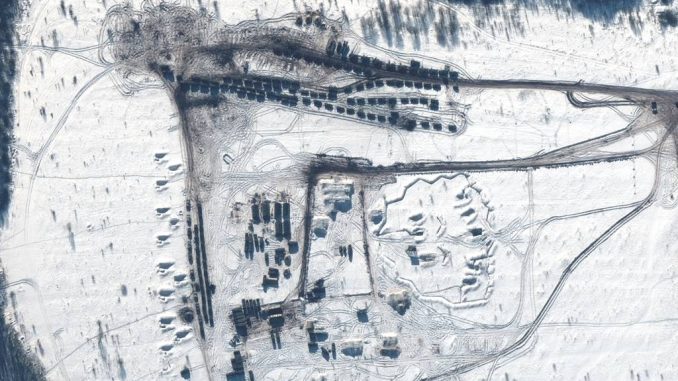
Russia actually added another 7,000 troops to the region, according to White House officials on Wednesday as satellite images captured in the last 48 hours seem to bolster skepticism the United States and its NATO allies have about the Russian assertions that it is withdrawing forces surrounding Ukraine.
The White House statements to Associated Press reporters about the new Russian troop buildup follows reports from the State Department that Russia has not withdrawn troops. During a televised address on Tuesday, President Joe Biden said that there were more than 150,000 Russian troops arrayed around Ukraine, and that, despite protestations otherwise, they were poised to attack.
A day later, administration officials said the Russians continued to add forces to the border areas.
“More Russian forces, not fewer, are at the border,” State Department spokesman Ned Price said to reporters Wednesday, adding, “and they are moving, concerningly, into fighting positions. This is cause for profound concern.”
Price reiterated what U.S. officials have been saying for weeks: an attack on Ukraine could happen at any time.
“We’re not going to get into precise timeframes, but the fact remains — and we’ve communicated this very clearly to our partners, to our allies across Europe and beyond — that the Russian Federation has in place now what it would need to undertake an attack against Ukraine.”
Maxar Technologies has been monitoring military movement around Ukraine over the last several months. According to a representative, images released Wednesday indicate heightened military activity in Belarus, Crimea, and western Russia, including a floating bridge placed over the Pripyat River in Belarus, less than five miles from the Ukraine border.
In a release, Maxar Technologies described Russian troop movements in the region.
Belarus:
- A new military pontoon bridge has been established over the Pripyat River, less than six kilometers from the Belarus-Ukraine border.
- Troops and armored equipment remain deployed in the Brestsky training area near Brest. Self-propelled artillery units continue to conduct training in the area; additionally, troops and equipment are positioned at the nearby Brest railyard.
- Troops and equipment remain deployed in the Osipovichi training area. A new, large field hospital is present and local training activity is in progress.
- Most of the equipment and troop housing area that had been present near Rechitsa has departed. A military convoy was seen moving west on today’s imagery.
- A new attack helicopter unit (consisting of nearly 20 helicopters) has arrived at Zyabrovka airfield. The significant troop and ground forces units that had been recently deployed to this airfield have departed and are unaccounted for.
Crimea:
- Troops and equipment remain deployed in the Opuk training area along the Black Sea coast. Artillery units continue to train in the area and several groups of equipment has been positioned in convoy formation.
- Troops and equipment remain deployed along Lake Donuzlav and the Novoozernoye area. Artillery units remain deployed in the fields near the garrison and troop tents also remain nearby. Several large sets of armored equipment were positioned in convoy nearby.
- Armored vehicles are seen positioned at the Yevpatoria railyard and may be preparing to depart. Additional military vehicles are seen in convoy at the nearby airfield/garrison.
Western Russia:
- Troops and equipment remain deployed throughout the Postoyalye Dvory training area east of Kursk. Battle groups and sets of military equipment are positioned in convoy formation in several locations.
The Pentagon deferred to Biden’s comments Tuesday. Biden said Russian claims that its military units were returning to home bases were not verified and that the U.S. “will defend every inch of NATO territory with the full force of American power.”
NATO Secretary-General Jens Stoltenberg called Russia’s military buildup “the biggest concentration of forces in Europe since the Cold War,” saying while he welcomes diplomatic efforts, there are no signs of de-escalation, and no withdrawal of troops.
“This may of course change. However, what we see today is that Russia maintains a massive invasion force ready to attack,” Stoltenberg said.
RELATED
:quality(70)/cloudfront-us-east-1.images.arcpublishing.com/mco/7WRGPCJYFZCUNFSEGQ2BSOXUCE.jpg)
His comments came at a meeting this week in Brussels, where NATO defense ministers began planning options to strengthen defense in eastern, and southeastern Europe. One potential choice could be new battlegroups in the region, but Stoltenberg said military commanders will work on details in the coming weeks.
Russian President Vladimir Putin has denied allegations Russia intends to invade Ukraine, and made requests that NATO not extend membership to Ukraine or other former Soviet Union nations. NATO’s founding treaty promises membership is open to countries that want to join.
“Moscow has made it clear that it is prepared to contest the fundamental principles that have underpinned our security for decades, and to do so by using force,” Stoltenberg said. “I regret to say that this is the new normal in Europe.”
The U.S. already deployed troops to support NATO nations Germany, Poland, and Romania, with the promise that American troops will not enter Ukraine if there is a Russian invasion.
Ukraine is not a NATO member, but the U.S. has provided military aid.
The State Department recently closed the U.S. embassy in Kyiv, moving diplomats out of the country and advising all Americans who are there to leave.


Be the first to comment